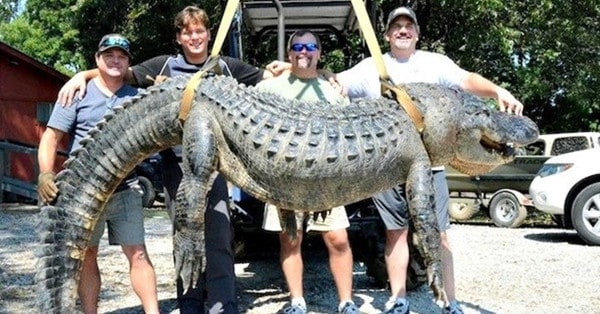
The story of a group of Mississippi hunters who shot and and killed a 910-pound gator recently, and found civil war bullets in it’s hide, is going viral again. Outdoors360 was prepared to link to the story, and provide additional details and information regarding the story, but it turns out there’s more (or less) to this story than originally reported.
The original story was published here: Original story
From the World News Daily Report website they have this disclaimer (in all caps):
DISCLAIMER
World News Daily Report is a news and political satire web publication, which may or may not use real names, often in semi-real or mostly fictitious ways. All news articles contained within worldnewsdailyreport.com are fiction, and presumably fake news. Any resemblance to the truth is purely coincidental, except for all references to politicians and/or celebrities, in which case they are based on real people, but still based almost entirely in fiction.
Most scientists estimate that gators live between 30-50 years in the wild. So, with a total lack of evidence, sources, and even names to back up this story, we feel confident in labeling this story : FALSE.
With all of this being said, there’s another reptile that has been reported to actually contain Indian artifacts and bullets from the civil war. That equally intimidating creature is the alligator snapping turtle. In fact, this idea has been mentioned numerous times in major media, including Dirty Jobs with Mike Rowe on Discovery Channel.
Marty Stouffer’s Wild America also did a feature on an episode titled “The Truth About Turtles.” On this episode turtle trappers like Al Redmond, who harvested the turtles for soup companies had some interesting observations about the giant turtles:
“As we was butchering these larger turtles that come off the Flint River, we noticed cracked shells, indentations in the shells, and as we was slaughtering these turtles, we started finding Indian artifacts–arrowheads, spear-points, where they had been shot and imbedded. Usually in the tenderloin in the back would be a large growth. Sometimes you could see part of the point sticking out, sometimes it was totally covered up. And something else, too. We was finding musket balls. this right here, and also the 50 caliber sharps bullet was used during the Civil War which was in the early 1860’s, are found several of these where they had shot these larger turtles. We knew these turtles was old, but we didn’t know they was that old.”
Al has since stopped killing the snapping turtles and dedicated his career to their survival.
 Photo courtesy of Rural Missouri: John Richards with an alligator snapping turle
Photo courtesy of Rural Missouri: John Richards with an alligator snapping turle
Others are more skeptical including John Richards, aka The Turtle Man. John had this to say in an interview with MFS’ Fr. Phil Hoebing regarding the civil war souvenirs in these turtles:
” Turtles with arrowheads and Civil War musket balls in their shells? I don’t believe it. I’ve heard those stories from many people.Think about it. How is someone going to catch a turtle that big in those days? That was before hoop nets. Shoot it? How would they have seen it? They are nocturnal animals. They don’t even move during the day. They might come up for air once or twice a day, but all you’re going to see is the tip of the snout. You’re not going to have anything to shoot at. I’ve heard of arrowheads in these things, musket balls in their shells, and I ‘m sorry. Now that’s a great story and that authenticates the fact that these animals get really old, and we know that anyway. But I just don’t buy the fact that the Indians or the Civil War soldiers or whatever are gong to run into these things.”
One factor that makes this more plauisble is the fact that tortoises are notorious for their long life spans. From OneKind.org : The largest living species of tortoise that can survive well past a hundred, with the oldest recorded at 152. The most famous Galapagos Tortoise was ‘Lonesome George’, a sub species who lived on the Islands, he was 100 years old and still classed as a young adult! He had become an ambassador of sorts for the islands off the coast of Ecuador whose unique flora and fauna helped inspire Charles Darwin’s theories on evolution.
Our conclusion : Definitely maybe true.







